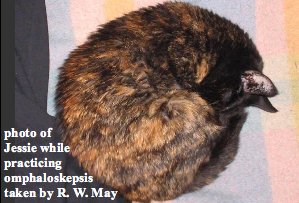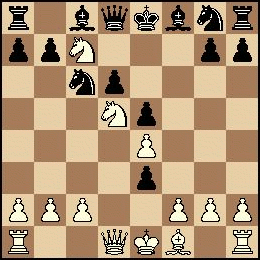Whenever Joey passed Hyde House, he pushed his nose between the bars of the tall wrought-iron fence and stared into the garden of giant green animals. A seated bloodhound raised its green snout skyward; shadows etched folds in its mournful face. A rattlesnake spiraled upward in stacked coils towards an arced neck and poised, vigilant head; an iguana as long as Joey's backyard basked in the sunlight, watching him with one hooded green eye while its crisply demarcated scales glowed. In the center of the garden, the great cat head rose as high as a house, its ears pitched forward alertly, its oval eyes focusing intensely; alternating lines of darker bluish-green and pale jade green striped the face in a tabby-cat pattern.

"It's a topiary, Joey," his father said. "They prune bushes in the shapes of animals. Probably yew bushes up there, but I can't be sure; I never got close enough to see the leaves, and neither has anyone else I know."
"I'd stay away from there," his mother warned, "They say it's a bad place".
When he walked home from school, and on Saturdays when his mother thought he was playing ball with the other boys, Joey stopped at the fence. Never interested in art before, he pulled out a sketchbook and green pencil, and sat for hours by the fence drawing the animals he saw. He took the sketchbook home; at first, he only drew in his room, then he drew in front of the TV, then at the dinner table when he was supposed to be eating.
His father noticed how detailed and lifelike the drawings were, like the renderings of a mature artist, and marveled at the boy's long hidden talent. His mother noticed how each of the lifelike animals was composed of tiny leaves and how the skeletons, barely visible under the green covering, were built from branches with thick, scaly bark.
"Maybe you should try drawing something else, Joey," she suggested, working to hide her frown. "And use other colors, not just green". But Joey continued drawing calmly; he didn't even glance at her or shrug. Talking to him when he was drawing was like talking to a ghost.
"You really should stay away from that house; I've seen you up there, peeking through the fence," a visiting neighbor warned. "Bad people lived up there, maybe still live up there."
"What do you mean, 'bad people'?", Joey asked.
"Well, I don't know if I believe it myself, but some of the old timers say that Miss Hyde was a witch, the last in a long line of witches who lived up there."
"A witch!" Joey's mother snickered as she set pound cake on the table, urging Joey and the guest to eat. "She was an eccentric, that's for sure. Any woman who builds a new wing on her house, so that each of her ten cats can have its own bedroom, qualifies an odd ball. Maybe even a card-carrying wacko. But a witch?" The cats lounged on velvet seats and eiderdown comforters draping state-of-the-art mattresses under ceilings painted with frescos of leaping, wide-eyed mice. At last sighting, the old recluse's gray hair jutted in matted spikes around a drawn, ashen, beak nosed face, but that fit a crazy woman who never went outdoors.
Joey let the pound cake soften into a mushy sweetness that coated his tongue, washed
it down with a gulp of Coke, and listened as the dancing carbonated bubbles pricked and teased the inside of his mouth. The sketchbook bulged in his back pocket, a hard rectangle straining against the denim, momentarily forgotten.
"But there are stories," The neighbor insisted as she poured grown-up black coffee into a grown-up china cup. " Stories from reliable people, not just tall tales from drunks staggering behind O’Hara’s Bar. Like the story, from Judge Hendricks himself, that no one's ever seen a bird or a squirrel or a rabbit or even an insect in that garden. With all that shrubbery, one would expect to see a robin or a rabbit wouldn't they?"
Joey's mother poured cream slowly into her coffee, watching the white cascade as if watching a world moving in slow motion. "But," she drawled, "You wouldn't notice a robin unless you were looking for one. And if everyone rushes by the place, afraid to look in because they think its haunted, then who's going to see a bird? They don't stop to look at anything in there."
Joey felt for his green pencil, a stub wedged in the bottom of his shirt pocket; mother's point was logical.
"Well, some people have looked," the neighbor snapped. "Watched the place for an hour, according to Judge Hendricks. And what do you make of all those stories of small dogs getting loose from their leashes, squeezing between the fence posts, racing into the garden and never being seen again? Like Mrs. Hunt's pekinese? Or the doctor's iguana? Or Mr. Marchand's dachshund? Don't tell me the dachshund got lost in there. That was a hound, and hounds can smell their way home through a garbage dump."
Joey's mother slid the pound cake back into its cellophane wrapping and shrugged. "Stories. Small town legends. Maybe the dogs were eaten by a coyote or fox that lives up there; it wouldn't be the first time that a coyote snacked on a pekinese. Or maybe the dogs ran out the other side, wandered a little further, and got taken home by someone driving down the highway. Wouldn't be the first time that a cute dog got stolen either."
The neighbor sighed. Joey's mother squeezed the carton of cream into the refrigerator, snugly between a pot of left-over stew and a plastic vat of low calorie, low fat, calcium fortified artificial butter.
"It's not like I encourage him the go up there, I've told him a hundred times to keep away." She glared at the boy. "But not because of any witches. Just because the old crone, who'd only be 80, might still be alive in there and quite mad. Mad enough to greet visitors with a loaded Remington. Or mad enough to have let all her cats turn feral in their velvet bedrooms. If we really worried about our kids' safety, we'd call Social Service or the Area Agency for Aging, have a professional look at the woman; she might need a hospital."
Everyone had heard the "Granny Get Your Gun" story. Miss Hyde had stomped across her porch floorboards, a threadbare taffeta gown dappled irregularly with fuchsia swishing behind her, and threatened the UPS delivery man with a rifle; the man noticed the hair legs and yellow talon toenails, stammered apologies as he backed away from the crevice-thin lips and pointing gun, then fled to his truck and quit his job the next day. Gossips reported that Miss Hyde had painted all the first floor windows black on the inside, so that no one could see in, and that she fed herself for years without ever leaving the house or accepting visitors. Joey wondered how the adults, who avoided the house and its hexes, knew about the painted windows.
"What do you make of the story that no one's ever seen a caretaker or gardener on the grounds, while the topiary remains perfectly pruned? That kind of garden needs a lot of maintenance; it's not a made-for-convenience, seed it and forget about it variety." The neighbor leaned against the back door and folded her arms across her chest.
"I don't know, " Joey's mother muttered. "But Joey's not stopping there any more, are you Joey?"
Joey shrugged and felt for his sketchbook.
Joey waited until he heard his father's rhythmic snoring; then he climbed out his window, tiptoed across the flat porch roof to an overhanging maple branch, crawled along the branch until he could drop to the one beneath it, then jumped to the cool, sound absorbing grass. Escape always was easy; a soft thud never awakened his parents, not in a house where settling walls and the wind interrupted the night with frequent thumps and creaks.
Joey didn't believe in witches, in a Hansel and Gretel world where wart faced hags shoved kids into ovens, roasted them, and chopped them into mincemeat eaten alongside a peppery soup of boiled cat and sautéed frog eyes. That was the land of tooth fairies with dragonfly wings, hop-along chocolate Easter bunnies, Santa Claus and magically fleet reindeer with electric red noses. Joey had grown too old and big for that world; he bumped his head on its ceilings.
Now, with good Samaritan busybodies watching out for him by day, he had to visit the garden at night, when everyone but the man in the moon slept.
He poked his nose between the bars and gaped at the giant cat head, gray and black, instead of green, at night. The eyes, luminescent and nocturnal, glowed with the inner fire of opals. In the moonlight, the spiky twigs jutted up from the ears, even more starkly hair-like than by day. The hum of traffic on the distant highway calmed and reassured him, like a purr from the cat's belly deep within the earth.
The fence was high but he could scale it; he wedged his shoe between the wrought iron vines that looped and swirled around the support poles, and climbed.
Joey inched forward, then stopped. If crazy old Miss Hyde was a witch, her topiary animals might come to life, charging him with horns as long as his bedroom; the sleeping green hound might awaken to guard duty and devour him in its snarling fanged mouth. The cat head might rise out of the soil, on great earthen loins that transformed into furry brown haunches; the cat mouth might hiss and rain spittle on him from three storeys up. He minced closer, seeing for the first time each of the slender veined leaves on the iguana's back; nothing snorted or rusted in the windless garden.
Mrs. Hyde wasn't a witch, he told himself, just an old lady with eccentric tastes in gardening and pet care. Silently, he slipped off each shoe and strolled barefoot through the grass towards the garden's interior that no one could see from the fence. Dirty shoes, encrusted with street grit and patches of hardened gum, would defile the lawn and its poised, perfect menagerie. He suppressed a cough; even the softest grunt would taint the purity of the cool, weightless, expectant silence.
"Don't go there," Joey recalled his mother's voice, sharp as a snapping twig. "And can't you use a different color pencil? Not just green?"
Joey tiptoed past topiary raccoons and toads. If he had his sketchbook now, he'd color the animals the bluish silver of moonlight reflecting off shiny leaves, draw them shining against shadows as black as windows darkened against the world. He swatted at a gray speck that fluttered in front of his face and landed to tickle his arm; then he rubbed away a dark blotch and a powdery wing. The adults were wrong; insects did live in here.
"Don't you wonder why no squirrels or birds live in there? With so many plants, you'd expect lots of birds." He heard the neighbor's nasal voice that sterilized life with its nearly ultrasonic screeches; recalling her talk, he momentarily saw the moon as a scoured white ball dripping antiseptically thin blue light over bushes as coldly untouchable as perfectly buffed chrome.
"And what about all the dogs that wander in and never come out?" He remembered the neighbor's siren-voiced warning and his mother's rational explanation that the place was only an old jerry-built house and garden, owned by a lady who'd perhaps gone mad after decades of solitude. The owner might need a psychiatrist, but this didn't mean that her eccentric garden was jinxed or enchanted.
A rabbit dashed past him, then leaped into the shadows. For a second, the shadows seem to pulse, enlarge before shrinking to their former size; Joey told himself that he was seeing tricks of the moonlight, and that he was letting himself be influenced too much by a neurotic neighbor's fears. A small bird rustled up from the silhouetted ear of a horse, then dipped towards the unlit flank of a giant evergreen guinea pig. Joey turned from the damp lit grass towards the cluster of animals grazing in shade.
"Don't go there, " the neighbor's voice rasped.
"This is better than any school field trip," he thought. "Next to this, the Empire State Building's nothing. Those teachers who think the Statue of Liberty's such a great sculpture should come here, living art a block from their own back yards. Bushes sculpted to look just like dogs and rabbits, nothing out of proportion. Next to this, the Statue of Liberty's just a hulking woman holding a torch that looks like a cone of gray cotton candy."
In the shade, an orchestra of chirping crickets, piccolo voiced mosquitoes and thrumming frogs played untitled symphonies never imagined by Beethoven. Birds caroled and trilled operatically until the music congealed into something palpable, something which teemed around him and absorbed him into its soul, but which he could also hold in his hand like a radiant amethyst nugget. He stared into the black drapery of shadows, not caring that he saw only black.
"It's a dangerous place," the busybody neighbor had warned. But what dangerous place offered its visitors amulets of perfect sound? He stood in place, transfixed.
He stood in place, vaguely aware of a tingling in his feet, then a stiffening numbness that crept up his calves and legs. A part of his mind thought that his legs might be falling asleep, while the rest of him fell into the outstretched, swaddling arms of the music.
"A hound can sniff his way home through fields of garbage. He doesn't get distracted by manure or exhaust fumes or even a lynch mob of skunks." The part of Joey which shared fear with the neighbor struggled against the mesmerizing lure of the music. As a cloud slid away, moonbeams lit the shady place and Joey glanced down.
He glanced down again. A thick skin of bark coated his legs. Tiny twigs, ending in pale young leaves, sprouted from his shins and calves. Gnarled roots twisted out from his woody feet, down into the moist, cool, hard-packed earth; his feet tingled and twitched as the roots pushed to stretch and uncoil in the mud and suck up water and minerals. His arms were rough and scaly, the skin on his shoulders course but still pink. He tried to bend his elbow; the joint was locked.
Joey tried to scream; he couldn't. Woody fibers stiffened his face. Tendrils blossomed from his cheeks and chin, then hardened into branches. Buds exploded open. Joey watched as branches divided, multiplied and thickened around him. He watched as leaves multiplied into a mane around his face. He watched until the thick, growing foliage blinded him to the moonlight and deafened him to the once mesmerizing songs.
At dawn, long before the town busybodies awoke, Miss Hyde prowled her garden, stopped near a cluster of bushes and noted that a new animal had been added to her garden of perpetually pruned, perfectly sculpted topiary.























